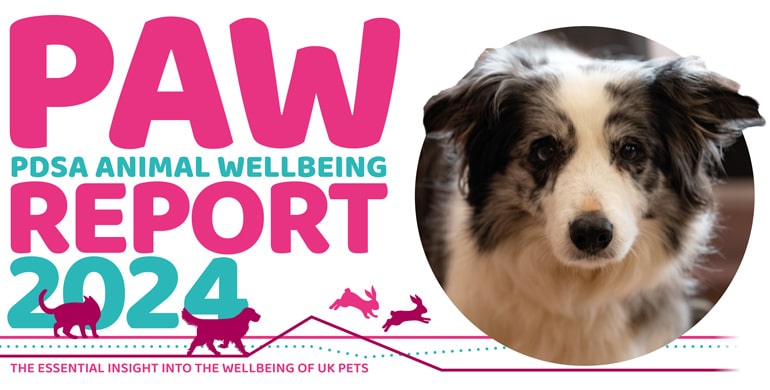Dogs
Owners report benefits that pets bring to their lives. 92% of dog owners agree that owning a dog improves their life, 86% say it makes them physically healthier, and 88% say it makes them mentally healthier. How does this correspond with the care their dogs receive?
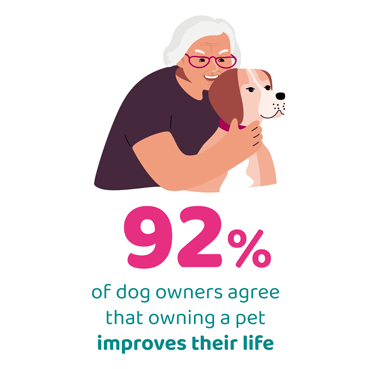

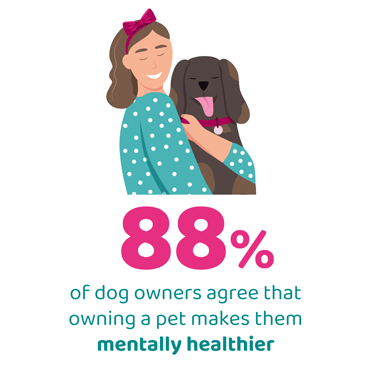
Companionship
89% of owners told us they felt informed about their dog’s need for companionship, which was the lowest proportion of all the Welfare Needs. Dogs are social animals and can be negatively affected by being left alone for long periods, although it is also important to ensure they are given the opportunity to rest undisturbed.
Our findings show that the amount of time that dogs are left alone for is continuing to return to the same levels as in 2019, before the COVID-19 pandemic resulted in many owners being at home with their pets for longer periods of time. In 2024, 19% of dogs are left alone for five or more hours, significantly more than in 2022 (15%), no different from 2019 but less than in 2018 (24%). This could be because fewer people are still working entirely from home6.
26% of dogs are never left alone on a typical weekday, which is significantly lower than in 2022, when it was 32%. It is important for many dogs to spend some time alone, to allow them to rest without disturbance. Dogs need to be taught to be confident spending time alone7, even if their usual routine involves someone being at home with them for most of their day. It is difficult to tell from these findings whether dogs are being given the opportunity for undisturbed time, but we did find that fewer dogs left for longer periods (5 or more hours) show signs of distress when left alone (8%) compared to dogs left for 0-4 hours (12%) or never (15%). One possibility is that owners may have reacted to dogs showing signs of distress when left alone by finding a way to ensure they are never in this situation. It is also possible that dogs left for longer periods have become more accustomed to being left over time, or potentially just not observed if they do have problems. Either way, leaving a social species like dogs alone for these longer periods can be detrimental to their welfare.

Behaviour
The 2024 PAW Report has revealed some concerning results surrounding dog behaviour, particularly in the proportion of confrontational responses dogs show and the training methods used by owners. Dogs that display human- or other animal-related confrontational related behaviour are an important public health concern. While the proportion of dogs that have bitten a person or other animal may seem low, when considered at a population level, the numbers of dogs showing this behaviour are of concern. We asked owners whether their dog had ever been bitten or had themselves bitten or chased other animals or people. 82% of owners told us that their dog had never been involved in any of these situations. However, 5% have been bitten by another dog away from home where veterinary care was needed (570,000 dogs), 2% (180,000 dogs) have bitten a familiar dog and 3% (350,000 dogs) have bitten an unfamiliar dog. In addition, 1% have bitten their owner or carer where professional medical care has been needed (150,000 dogs), however, this is likely to only capture the more severe bites, and those where medical intervention wasn’t warranted may be considerably higher. These proportions are unchanged from 2023.
The literature suggests there has been an increase in dog bite cases in recent years. The number of dog bite–related hospital admissions in England between 1998 and 2018 showed an increase in adult cases8. This year, we found that significantly more dogs in 2024 have bitten a stranger in the home where professional medical care has been needed (1.2%) compared to 2022 (0.55%). It is important to note that we do not know in what context any of these reported bites occurred, and there are multiple potential factors, both human and dog related, involved in the increase in dog bite incidents9. However, this worrying increase suggests that further bite prevention strategies are warranted including education surrounding dog body language and safe interactions, recognition of dog pain and illness, and meeting dogs’ needs.
Another behavioural concern is unwanted behaviour around livestock which can present a serious risk to other animals. In 2024, we have seen an increase in the number of dogs that have chased livestock, 6% compared to 4% in 2023. Livestock worrying is a significant welfare concern for a range of stakeholders and can result in major financial and emotional suffering for farmers and livestock keepers10. Ensuring dogs are kept secure around livestock is essential to help prevent worrying and protect the welfare of dogs and livestock.
An issue that may be contributing to confrontational behaviour and poor welfare in dogs is the use of aversive training methods. This year we have found that 22% of dog owners have used aversive methods* as a training aid. There are significantly more owners using one or more of these aversive devices compared to 2022 (20%), but fewer than in 2019 (25%).
In 2024, 15% of dog owners have used one aversive method for training, 6% have used two aversive methods, and 1% have used three aversive methods. Of those owners who used aversive methods to train their dog, the behaviours they were attempting to correct included barking (43%), pulling on the lead (37%), elimination in the home (20%), growling, snapping, or biting people (12%) or other pets (12%), and chasing livestock (12%). The efficacy of these aversive methods is questionable and there is a high risk of these tools being used incorrectly11. Moreover, the use of aversive methods can cause physical, emotional, and cognitive harm to dogs12.
Significantly more owners who have used aversive training aids have dogs who show concerning behaviours compared to owners who used food or treat rewards (see infographics). These include worrying behaviour towards owner’s children, growling, snapping or biting owners/carers, growling, snapping or biting unfamiliar dogs, and growling, snapping or biting other dogs in the household, as well as dogs who have chased livestock, and those who have bitten a familiar or unfamiliar dog. Worryingly, we also found this association with dogs who have bitten a human where professional medical care was needed, whether their owner or carer, a stranger in the home or a stranger outside of the home. Additionally, 18% of owners who have used aversive methods of training told us their dog was showing signs of distress when left alone, compared to 12% who use treats and food rewards.
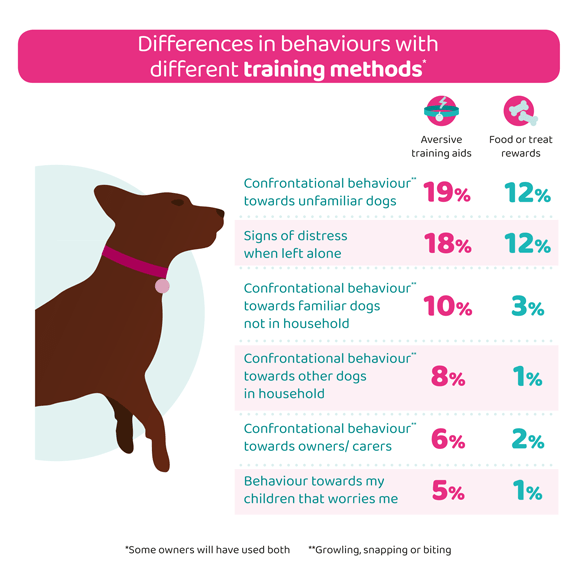
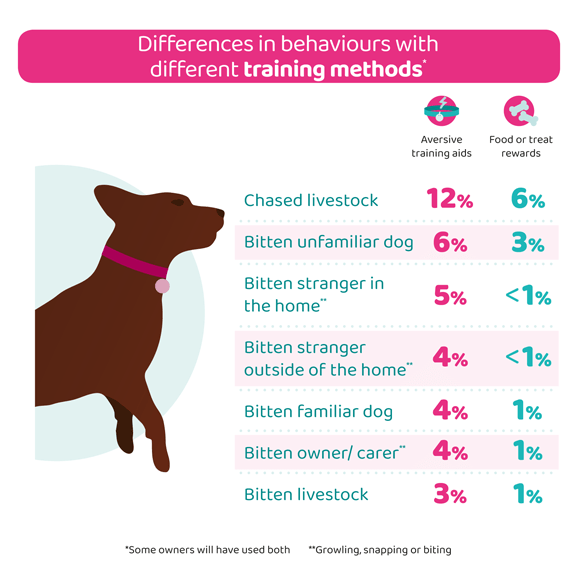
It is important to highlight that we cannot infer any causal effect from these data, just that there is an association between certain behaviours shown and aversive training methods. It may be that these behaviours are more likely to make an owner feel they need to use aversive methods to modify the behaviour, or that the use of aversive training methods could cause a dog to develop further concerning behaviours. It is also important to note there may be some owners who use both aversive and reward-based training aids.
We asked dog owners what behaviours their pet was showing. 16% of owners told us that their dog was showing growling, snapping or biting behaviours, which are likely seen in states of protective emotional bias13 and may be indicative of poor welfare. 12% were showing signs of fear, 11% were growling, snapping, or biting unfamiliar dogs and 2% were growling, snapping, or biting their owners or carers. In addition, 11% of dogs show signs of distress when left alone and 2% of dogs show behaviour towards their children that worries the owner, equating to 170,000 dogs.
This year, we asked dog owners how much sleep their dog got in a 24-hour period. We found several associations between dog behaviour and sleep. Although the optimal sleep duration is likely to vary between dogs, there is evidence to suggest that dogs should get over twelve to sixteen hours sleep14,15,16. Our findings reveal that a large proportion of dogs are likely to not be getting enough sleep**, with 27% (2.9 million) sleeping for ten hours or less in a day, and 53% (5.6 million) of dogs getting under 13 hours sleep.

Confrontational behaviour was one of the associations we found to be linked to the duration of sleep. Significantly more dogs who get less than 10 hours sleep (4%) show growling, snapping or biting towards other dogs in the household compared to dogs who get more than 13 hours sleep (2%). Also, more dogs who get less than 10 hours sleep (6%) show growling, snapping or biting towards familiar dogs not in the household compared to dogs who get more than 13 hours sleep (3%). These results support the findings of studies which have shown problem behaviours may increase in dogs sleeping less than eight to ten hours16, highlighting the importance of providing the opportunity and correct environment for dogs to sleep to protect emotional health.
We found that the environment appears to have a significant impact on the duration dogs sleep for. Significantly more dogs with three to four (28%) or five plus (40%) people in their household are getting less than ten hours sleep, compared to those with two people (24%). Similarly, in households with one person or two people, 44% and 43% are getting more than 13 hours sleep, compared to 37% of dogs in three to four person households, or 28% in households of five plus people. Additionally, more dogs with children in their household get less than eight hours (8%) or eight to ten hours (24%) sleep compared to those with no children in their household (5% and 19% respectively). Conversely, fewer dogs with children in their household get 13-16 hours (28%) or more than 16 hours (7%) sleep compared to those with no children (33% and 9% respectively). This could suggest that busier environments with children may not be conducive to promoting sleep in dogs. Further research into the quality of sleep in these environments will provide additional insight into canine sleep health.
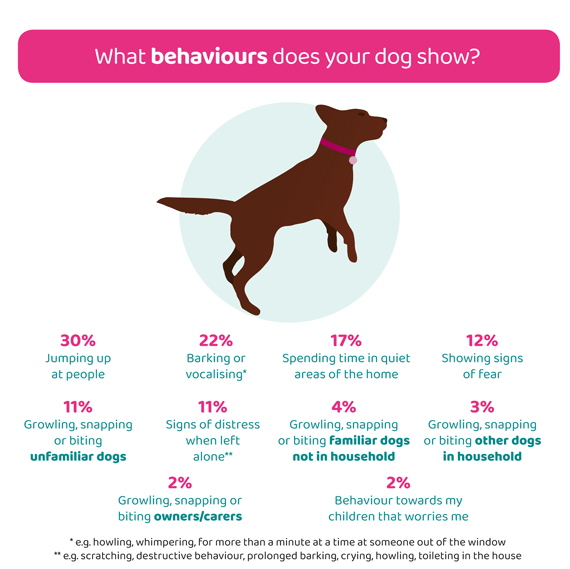
"Levels of reported dog bite incidents, together with the reporting of an association between the use of aversive training methods and the incidence of concerning canine behaviours, highlight the need for better education for caregivers about the dogs that they share their lives with. More information is needed to understand the reasons for the confrontational behaviours that are reported but the need for more effective dog bite prevention strategies and education about positive training methods is clear. The potential for a link between poor sleep duration and behaviours which caregivers find problematic is consistent with recent publications in the field of veterinary behavioural medicine and also warrants further investigation."
Dr Sarah Heath, FRCVS – RCVS and EBVS® European Veterinary Specialist in Behavioural Medicine
XL Bullies
In October 2023, the UK Government announced plans to add XL Bullies to the list of dogs banned in England and Wales under the Dangerous Dogs Act 1991. The legislation came into force on 31 January 2024 – from that date it has been illegal to own an XL Bully in England and Wales without a certificate of exemption. In January 2024, the Scottish Government announced their plans to introduce similar legislation, followed by the Northern Ireland Government in March 2024. Our findings show that as of January 2024, 9% of dog owners were not aware of the new XL Bully regulations at all.
0.69% of owners (73,000) chose to identify their dog as an XL American Bully or Bully when asked what breed their dog was, however 2.12% of dog owners (220,000) said their dog is definitely an XL Bully under the Government definition, and 3.16% said their dog could be considered an XL Bully, but they don’t think they should be. Owners with more than one dog were asked only about the breed of one of those dogs, which may mean these numbers are an underestimate.
A further 0.11% of owners told us they owned an American Pit Bull Terrier (approximately 12,000 dogs), a breed which has been banned in the UK since 1991. Data from the Department of Environment, Food and Rural Affairs (Defra) obtained in a Freedom of Information request submitted to the Government by the BBC17 showed 3,499 banned dogs are registered in the UK, of which 3,465 are Pit Bull Terriers.
0.08% of owners told us they owned an American Bulldog (approximately 8,500 dogs). The dimensions of some dogs of this breed could meet part of the legal criteria to be considered as an XL Bully, particularly as it is a breed not recognised by the UK Kennel Club. Concerns were raised that the conformation standard developed by Defra could cause confusion amongst owners18. There appears to be a significant proportion of owners who are struggling to understand whether their dog is now a banned breed.

There is also confusion about whether the legislation will be effective in terms of improving public safety. Only 28% of all pet owners think the public will now be safer. 11% think XL Bullies will no longer be seen in public at all.
We found significant differences in owners in London compared to the UK as a whole. Fewer dog owners in London are aware of the new regulations around XL Bully dogs (65% compared to 89% in the UK). More dog owners in London say their dog is definitely an XL Bully compared to the UK (9% of dog owners in London compared to 2% in the UK) and more dog owners in London compared to the UK say their dog could be considered an XL Bully but they don’t think they should be (15% compared to 3%). In total, 24% of dog owners in London say their dog definitely is or would be considered to be an XL Bully, which is much higher than the UK as a whole (5%).
“The lack of awareness and confusion around the breed ban reflect the experiences of those in the rescue and veterinary sector who have been inundated with requests for help and support since its announcement. With the ban yet to be fully implemented in Scotland and Northern Ireland, experiences in England and Wales highlight the urgent need for ongoing support for owners as well as sufficient time and clear and comprehensive information from Governments to help them navigate and adopt this change. This will also help ease the burden on professionals who remain under considerable pressure following the pandemic and cost of living crisis."
Dr Samantha Gaines. Head of Companion Animal Science and Policy, RSPCA and secretariat of the Dog Control Coalition.
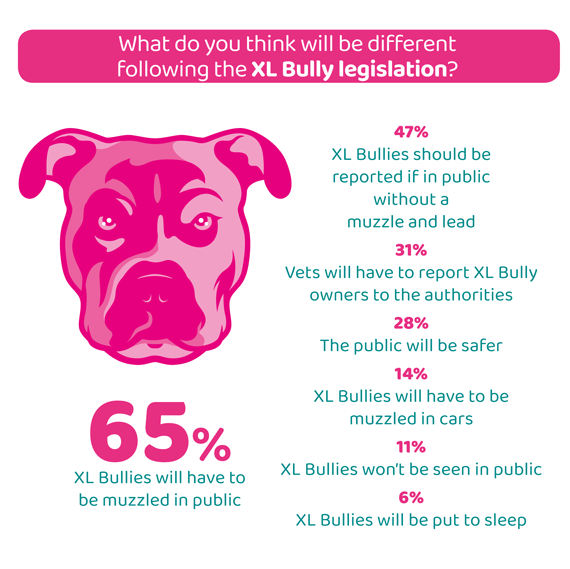
Preventive Health
Although the proportion of dogs who are neutered is the same as in 2023 (68%), it has decreased since 2019 when 74% of dogs were neutered. This may reflect increasing evidence for the benefits of keeping some dogs entire, particularly males19. More female dogs (75%) than males (63%) are neutered, and more owners say they haven’t neutered their dog because their vet recommended against it in 2024 (9%) compared to 2022 (5%). The proportion of dogs neutered increases with length of ownership***; 38% of dogs owned for up to one year are neutered, 56% of those owned for one to two years, 71% of those owned for three to five years, and 81% of those owned for five or more years.
80% of dogs have had regular booster vaccinations, no different from the findings in 2023 – this has fluctuated over our years of data, but the 2024 findings are no different from the average since 2017. Of those owners whose dog has not received regular vaccinations, 11% said it was because vaccinations are too expensive, which is not statistically significantly different from any of the previous times we asked owners about this since 2017.
Significantly fewer dogs are microchipped in 2024 (87%) compared to 2023 (90%). This has gradually decreased over time from 93% in 2017. In 2016, microchipping became a legal requirement for all dogs over 8 weeks of age20. The introduction of the legislation was accompanied by a great deal of publicity about the upcoming change, so it is possible that awareness amongst owners is now declining. Fewer ‘new’ pet owners (84%) have microchipped their dog compared to those who have owned a dog before as an adult (90%). However, of those owners whose dog was not microchipped, the proportion who said it was because they hadn’t heard of microchipping (8%) is no different from 2023 and lower than 2022 (15%).
64% of dogs are insured, significantly more than in 2023 (61%). This has been increasing since 2017 when it was 55%. However, in 2024, 45% of those who have not insured their dog told us they had not done so because it was too expensive, which has increased from 38% of uninsured dogs in 2023. More “new” pet owners (71%) have insured their dog compared to those who have owned a dog before (58%).
Of the 84% of owners who have treated their dogs for worms, 96% are doing so preventively. Likewise, 95% of the 81% of dog owners who are treating their pet for fleas are doing it for preventive reasons rather than treating an active infestation (3%). 63% of dog owners get their pet’s flea and worming treatment from their veterinary practice, 23% from a pet shop and 15% from an online pharmacy. With the increasing evidence of the environmental impact of routine parasiticides21, advice from veterinary professionals and the creation of tailored treatment plans, considering the specific needs of each pet's individual lifestyle are essential.
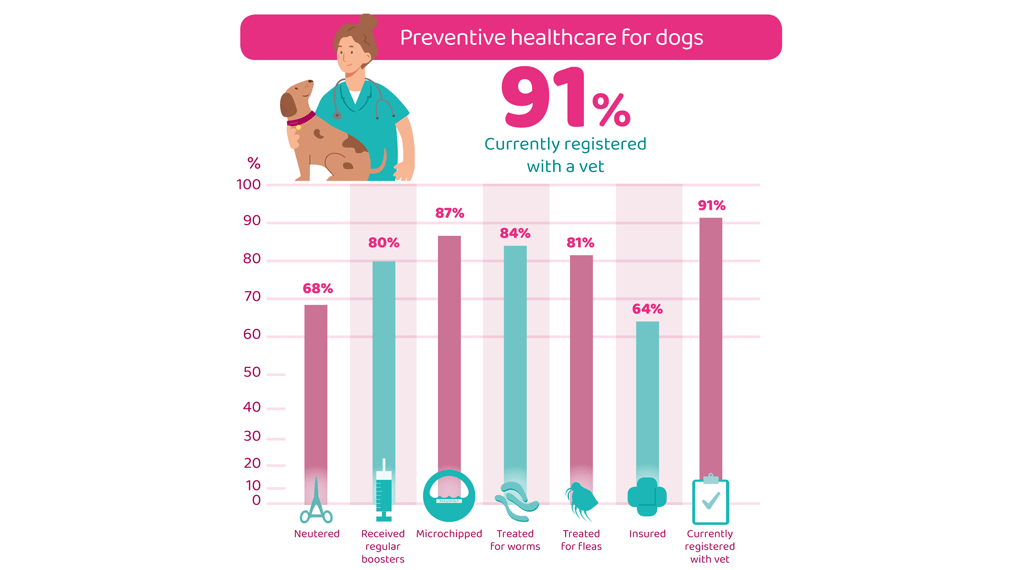
Cost of living
The rising cost of living continues to affect how owners care for their dogs - 26% of dog owners (2.8 million dogs) say the cost of living has affected how they care for their pet, which has increased from 23% in 2023. 35% of dog owners have made personal cost-saving decisions to continue caring for their pet, including 20% giving up personal luxuries, 16% making savings on their weekly food shop and 12% reducing energy consumption. 90% of dog owners say that the cost of owning their pet has increased.
8% of dog owners have delayed taking their pet to the vet when they were ill because they felt it was too expensive, which is no different from our findings from 2022 and 2023. There has been no change in the proportion of owners who told us their pet had not received preventive healthcare such as vaccinations (11% of dogs who are not vaccinated) or neutering (10% of dogs who are not neutered) because it was too expensive.
.
Key findings about dogs from our 2024 PAW Report
 Video found at youtu.be/ce5VODHSJJ4
Video found at youtu.be/ce5VODHSJJ4

Footnotes
* shock collar, citronella collar, electric shock collar, vibrating collar, pet corrector spray, water pistol or spray, rattle device, and choke chain.
** includes resting quietly, naps, and overnight sleeping.
*** excluding owners who didn’t know how long they had owned their dog.
6 https://yougov.co.uk/society/articles/47779-half-of-workers-now-working-from-home-at-least-some-of-the-time
7 Fagen, A. (2023). Separation-related disorders. Behavior Problems of the Dog and Cat: Behavior Problems of the Dog and Cat-E-Book, 297.
8 Tulloch, J. S. P., Owczarczak-Garstecka, S. C., Fleming, K. M., Vivancos, R., & Westgarth, C. (2021). English hospital episode data analysis (1998–2018) reveal that the rise in dog bite hospital admissions is driven by adult cases. Scientific Reports, 11(1). https://doi.org/10.1038/s41598-021-81527-7
9 Reese, L. A., & Vertalka, J. J. (2021). Understanding dog bites: the important role of human behavior. Journal of applied animal welfare science, 24(4), 331-346.
10 Oxley, J. A., Evans, B., & Montrose, V. T. (2017). Prevention of sheep worrying in the UK: Rethinking the approach. Journal of veterinary behavior, 19, 61-63.
11 China, L., Mills, D. S., & Cooper, J. J. (2020). Efficacy of dog training with and without remote electronic collars vs. a focus on positive reinforcement. Frontiers in Veterinary Science, 7, 547533.
12 Cooper, J. J., Cracknell, N., Hardiman, J., Wright, H., & Mills, D. (2014). The welfare consequences and efficacy of training pet dogs with remote electronic training collars in comparison to reward based training. PloS one, 9(9), e102722.
13 Heath, S. E. (2017, June). Canine emotions, behavioural responses and body language. In Proceedings of the BSAVA Northern Ireland Meeting.
14 Kinsman, R., Owczarczak-Garstecka, S., Casey, R., Knowles, T., Tasker, S., Woodward, J., Da Costa, R., & Murray, J. (2020). Sleep duration and behaviours: A descriptive analysis of a cohort of dogs up to 12 months of age. Animals, 10(7). https://doi.org/10.3390/ani10071172
15 Mondino, A., Delucchi, L., Moeser, A., Cerdá-González, S., & Vanini, G. (2021). Sleep Disorders in dogs: A Pathophysiological and Clinical Review. In Topics in Companion Animal Medicine (Vol. 43). https://doi.org/10.1016/j.tcam.2021.100516
16 Tooley, C., & Heath, S. E. (2022). Sleep Characteristics in Dogs; Effect on Caregiver-Reported Problem Behaviours. Animals, 12(14). https://doi.org/10.3390/ani12141753
17 https://www.bbc.co.uk/news/uk-67217993
18 American bully XLs: Owners confused by ban, says RSPCA - BBC News
19 Urfer, S. R., & Kaeberlein, M. (2019). Desexing dogs: a review of the current literature. Animals, 9(12), 1086.
20 Microchipping of dogs legislation (2015) https://www.legislation.gov.uk/ukdsi/2015/9780111125243
21 Mulcahy, G. (2024). Is it time to re-evaluate anti-parasitic use in companion animals?. Companion Animal, 29(3), 12-18.

